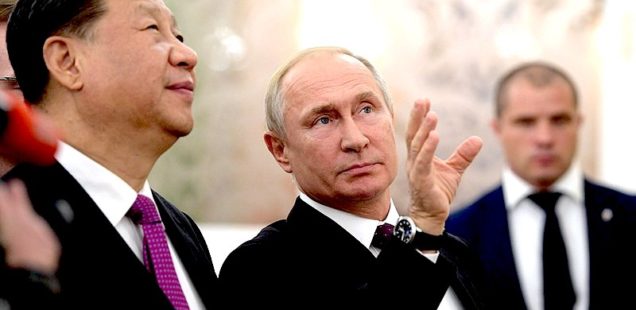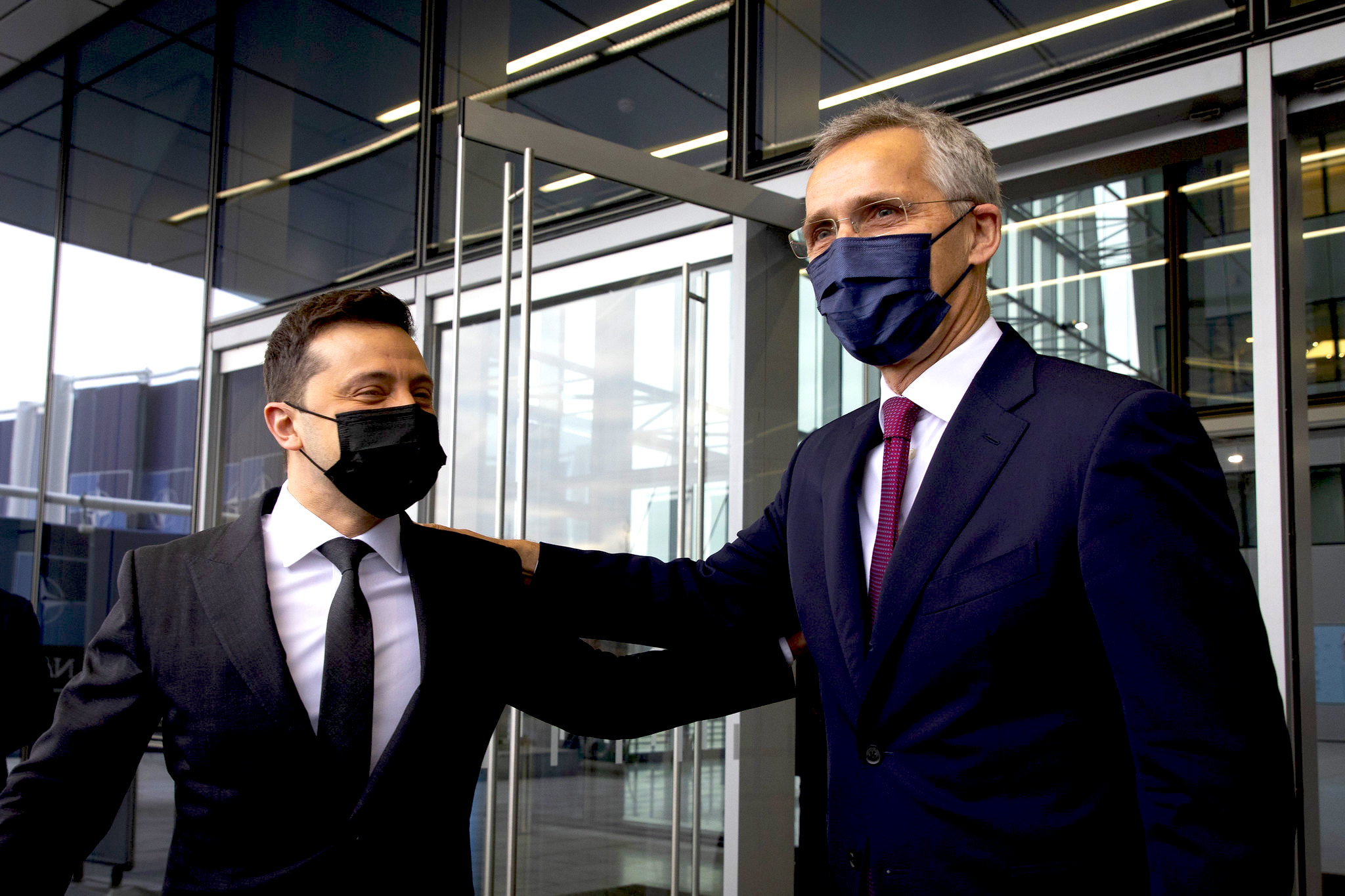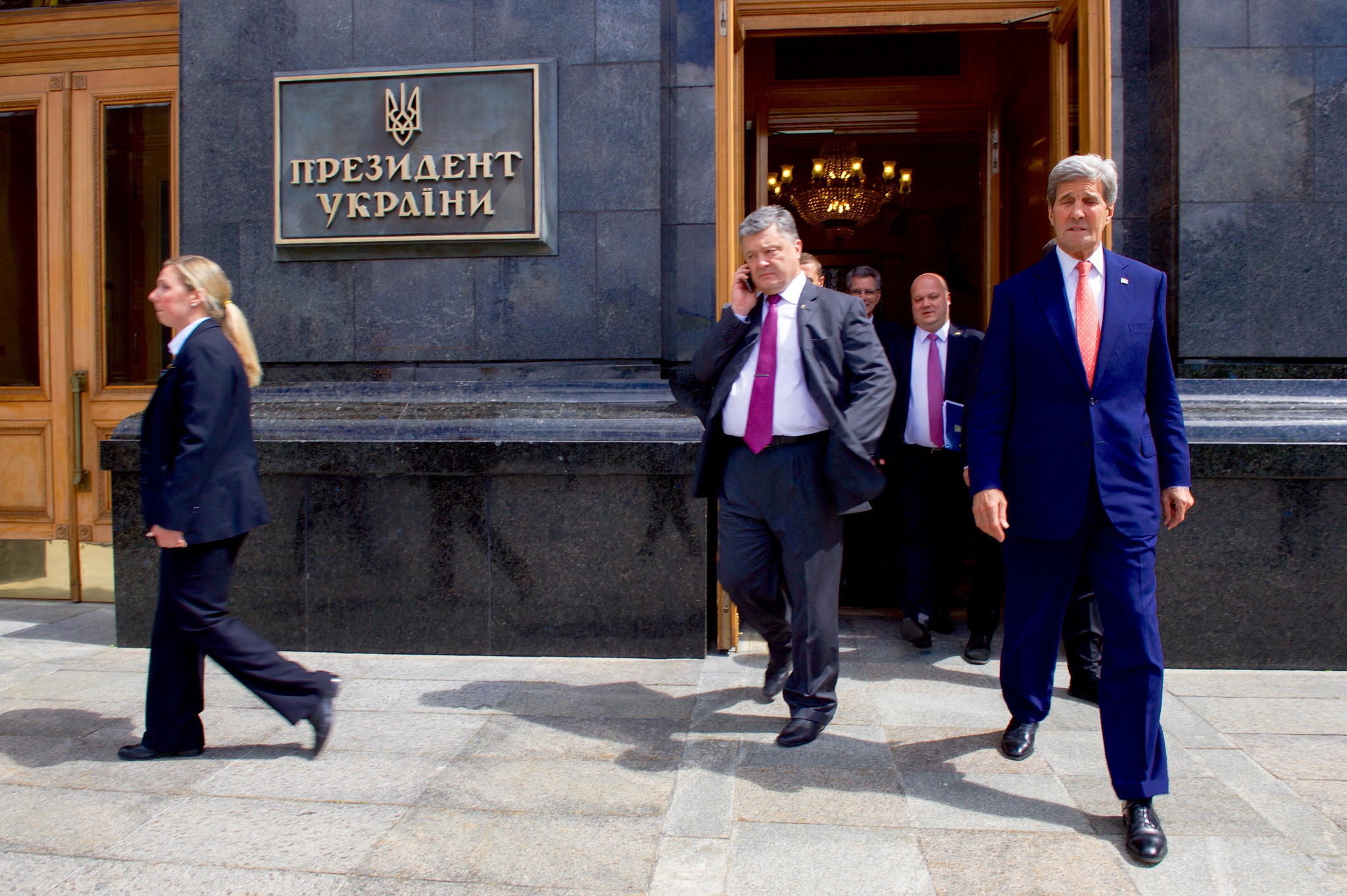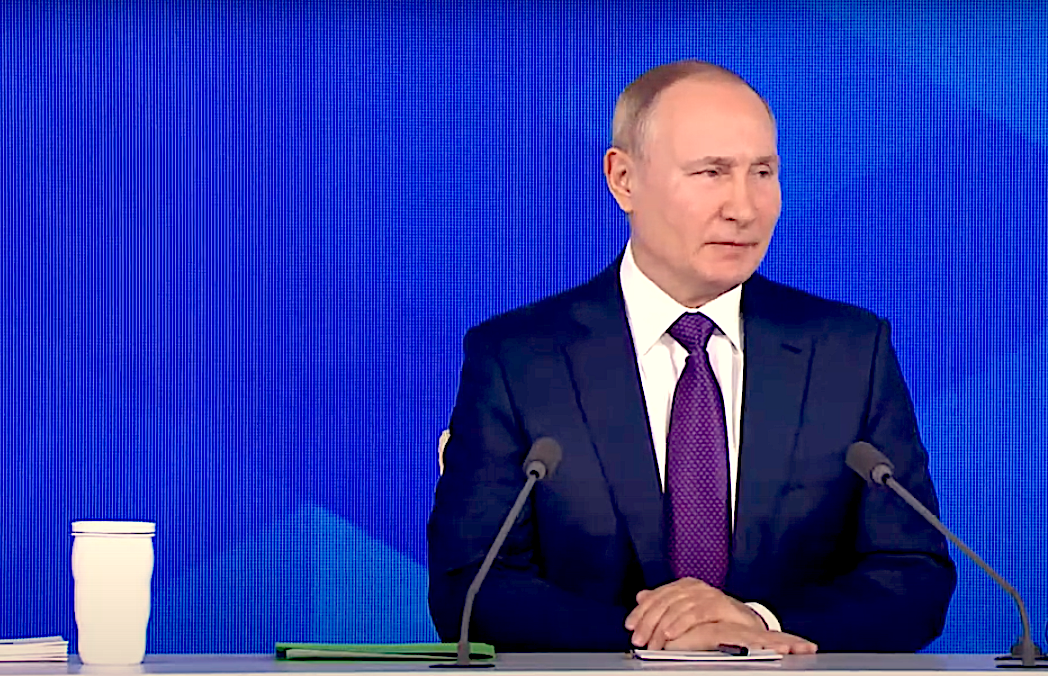
PATRICK LAWRENCE: Putin Speaks
As the Russian president’s year-end presser helped underscore, Europe will increasingly understand itself as the western end of Eurasia rather than the eastern shore of the Atlantic.
Vladimir Putin was “defiant” during his end-of-year press conference last Thursday. The Russian president, who has held these impressive question-and-answer events for the past 20 years, was “bellicose.” He was “threatening.” So we read in the all-the-same-always American press.
Here’s a gem from one Mary Ilyushina, a CBS News correspondent in Moscow: Putin is worried about the military activities of NATO members in Ukraine, she tells us, “you know, on Russia’s doorstep, which is what Putin believes Ukraine is.”
Putin believes. Got it. Mary Ilyushina, my nominee for president of the Overseas Press Club. I have other words for Putin’s performance before 500 domestic and international journalists, and it is far more pertinent to our circumstances. Putin was confident. He was clear, well-informed per usual, and meant neither more nor less than what he said.
I realize it is difficult for us, we Americans, to comprehend a political figure who is clear, well-informed, and means what he or she says. But this is what is noteworthy about Putin’s four-hour appearance. This is what’s worth our consideration.
Putin’s year-end presser, the Kremlin transcription of which is here, follows a series of developments that, in my read, has set in motion a profound shift in East–West relations as these play out along Russia’s border with Europe and across the Eurasian landmass.
“Putin wants to restructure the whole security architecture of Europe,” Mary Ilyunshina reported. Dead on this time, Mary. While Putin articulated no such thought, this is a serviceable summary of exactly his intent.
It is difficult to say just when the train of events now playing out between Washington and Moscow began. One can go back to the “civil society” funding the U.S. began sending Ukraine in the early post–Cold War years. But good enough here to mark down Ukrainian President Volodymyr Zelenskyy’s Sept. 1 summit with President Joe Biden as the occasion that set this recent phase in motion.
NATO & Ukraine

Zelenskyy wanted assurances that the Biden regime would hold his hand as he continued to ignore Ukraine’s Minsk II commitments and stoked increasing tensions with Russia. He got that. But he didn’t get what he truly came for: As noted in this space at the time, Biden stopped well short of any commitment to advance Ukraine toward membership in the North Atlantic Treaty Organization.
I may have misread that occasion as more of a setback than it was for the corrupt, Nazi–supported Russophobes running the Kiev regime.
What has since ensued leaves NATO membership well in the distance, but there are treaty documents and there are weapons shipments, infrastructure contracts, foreign mercenaries, purposeful naval provocations, and assorted other “facts on the ground.”
So far this year the Biden regime has approved $450 million is security assistance to Ukraine, bringing the total allotted since the U.S. inspired the February 2014 coup in Kiev to $2.5 billion.
During their Oval Office sit-down, Biden stayed awake long enough to promise Zelenskyy $60 million more in small arms, ammunition and radar systems. This materiel began arriving on Dec. 10 and will continue into the new year. Beyond that more, surely.
Britain is now at work constructing two naval ports along Ukraine’s Black Sea shoreline; in October the U.K. agreed to lend Kiev $1.6 billion to pay for an assortment of British-made naval vessels, some new, some outdated scows of the kind the West typically sells the non–West.
U.S. and British naval maneuvers off Russia’s Black Sea coast are now routine. Western military officials now talk of deploying potent new technology, all the way up to nuclear-capable missiles, along the alliance’s Russia-facing eastern front. We now have Russian reports that British mercenaries have joined the forces from NATO members already deployed in Ukraine. The numbers Russia is (unofficially) putting out: 10,000 troops and mercs from NATO members on Ukrainian soil, 4,000 from the U.S.
NATO–schmATO, if you see what I mean. The thought in Washington, London and Brussels seems to be, Well, we can’t put Ukrainian membership to paper —that might be a provocation too far — but, the hell with it, we can treat Kiev as more or less a member anyway.
Since the autumn we have had incessantly alarmist reports that the Russian Federation is amassing troops and materiel in its western region near the border with Ukraine. I read everything from 60,000 Russian soldiers to 175,000. Who knows? Maybe none, maybe the higher number (or higher than the higher number).
The Pentagon & Press
Our only certainty is that we cannot logically take the word of the Pentagon and its clerks in the press for what Russia is doing (on its own soil).
Be alert, readers! The West provoked the Cold War, left its provocations out and blamed Stalin’s Soviet Union for all that followed. The U.S. cultivated the coup in Ukraine seven years ago, left out copious evidence of this, and blamed Russia for reincorporating Crimea to protect its naval base on the Black Sea from the new crazies in Kiev.
Same thing once again. This latest crisis over the Ukraine question is the West’s doing, and — forgive the lapse here, please — the bullshitters in Washington are once again selling most of us on the idea that Russia is the aggressor.

I am reminded of that wonderful moment amid the earlier phase of the Ukraine crisis when John Kirby, then as now the not-too-bright Pentagon spokesman, complained to Matt Lee, the Associated Press’s able diplomatic correspondent, that Russia was too close to NATO’s eastern borders.
Everybody has to be someplace, as the old saying goes.
Everyone in Washington knows, just as you and I know, that Russia has no intention of “invading” Ukraine. This is merely the cover story blurring, in Washington’s seven-decade tradition, cause and effect.
When Biden asked for a video conference with Putin earlier this month, it looked to me as if our addled president wanted to come away saying, I talked tough and he retreated.
Six days after the two leaders’ video encounter, Sergei Ryabkov, Russia’s deputy foreign minister, handed his American counterpart two draft treaties that Moscow proposes as the basis of a comprehensive agreement to deescalate the dangerous situation Washington has assiduously conjured along Russia’s western frontier. One is a bilateral accord between Washington and Moscow; the other is a draft accord Russia and all NATO members would sign.
Unusually, the foreign ministry in Moscow published both documents two days after Ryabkov handed them to Assistant Secretary of State Karen Donfried. This was astute on Russia’s part: It leaves no room for Washington to misrepresent the Russian position. It also conveys the extent to which Russia intends to hold to its position even as it looks forward to negotiations in Geneva after the year turns.
Said position in sum:
- NATO will cease all efforts to expand eastward, notably into Ukraine and Georgia.
- NATO guarantees that it will not deploy missile batteries in nations bordering Russia.
- An end to NATO military and naval exercises in nations and seas bordering Russia.
- The effective restoration of the treaty covering intermediate-range nuclear weapons. The U.S. — yet again blaming Russia — abandoned the INF pact in August 2019.
- An ongoing security dialogue.
The talk in Washington and Brussels now is that these proposals are entirely unreasonable and that Russia understands this without saying so. The thought that Russia’s position is entirely unreasonable is … entirely unreasonable. Whether or not Moscow expects to negotiate down from these stipulations is an outstanding question.
Moscow Is Serious

Moscow’s seriousness is not. I was struck last Friday to find no less a figure than the nonagenarian Michail Gorbachev, who was famously betrayed on the NATO question as the Soviet Union gave way, laying into the U.S. during an interview with RIA Novosti for provoking the current crisis in Ukraine out of sheer “arrogance and empire-building.”
Here is how Putin put it in his press conference last Thursday:
“We have made it clear that any further movement of NATO to the East is unacceptable. Is there anything unclear about this? Are we deploying missiles near the U.S. border? No, we are not. It is the United States that has come to our home with its missiles and is already standing at our doorstep. Is it going too far to demand that no strike systems be placed near our home? What is so unusual about this?”
This is what I mean by confidence. In Putin’s diction I read a determination to protect Russia’s interests in the face of what the U.S. and its European satellites have turned into something approaching an existential challenge. Washington has given Putin no choice as it has turned up the heat — as it has aggressed — since the Biden–Zelenskyy summit. Moscow has taken its only alternative.
Corollary: Years ago, the late Stephen Cohen taught me to distinguish between spheres of influence, which we agreed was a 19th century terminology, and spheres of security, which are a 21st century reality. In effect, Washington is talons-out vigilant in guarding its own security perimeters — imperially defined as these are — while insisting there is no need to observe anyone else’s.
There are a couple of other factors to consider here.
One, as Moscow understands, along with what sane heads there may be in Washington, it is inconceivable that the West in any formation — via NATO, via the U.S. and Britain alone — could prevail in an armed confrontation with Russia over Ukraine. As my colleague Marshall Auerback has astutely argued, in this respect NATO’s recent belligerence on the Ukraine question, being ultimately impotent, will stand in history as the alliance’s Waterloo. Halle-damn-lujah if this proves so.
Two and more broadly, there is the question of history’s arc. Putin, having an active mind and a grasp of the moment — and how weird is this to Americans? — appears to understand that the Eurasian landmass, from Shanghai to Lisbon, is emerging as something like humanity’s new center of gravity (which marks a return of sorts).
Does Putin propose to restructure “the whole “European architecture of Europe?” In my mind he sees this as inevitable and thinks it is time to get on with it. Mary Ilyushina implies this is reckless, weird, unthinkable. It is none of these. We ought to celebrate the insight.
Europe, in other words, will increasingly understand itself as the western end of Eurasia as against the eastern shore of the Atlantic. Is it a coincidence that the Russian leader, a week after the video encounter with Biden, had a similar summit-via-video with Chinese President Xi Jinping that turned out to be the strongest affirmation to date of the alliance-like relationship between Moscow and Beijing?
I don’t think so.
In this connection, I loved the head on a story The Hill published after the Putin-Xi meeting. “‘Allies’ China and Russia Are Ganging Up on America,” it read. It takes a little fun out of it that Gordon Chang wrote the piece, given that the blindingly Sinophobic Chang is always wrong about anything to do with China. But still, good for a chortle.
Nobody’s ganging up on anybody, Gordy. It’s the turning of history’s wheel. Can’t you hear it slowly creaking away?


Wasn’t the Western corporatist media shrieking not so long ago that Mr. Putin had Parkinson’s ? He looks and sounds
very well, to me.
I’ve thought for quite a few years now that the West was headed for its own Perestroika; however, I did not think
it would involve our ultra-rich getting vastly richer in the
midst of a pandemic (or “pandemic”, depending on one’s
point of view), while saber-rattling at a couple of large and capable countries on which we’re dependent in many ways.
Regards at the New Year- I appreciate your thoughta, and the (rare) clarity of your writing.
CW